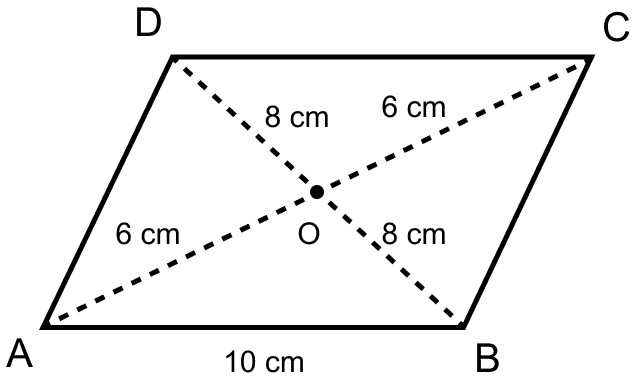Mathematics
ABCD is a parallelogram with side AB = 10 cm. Its diagonals AC and BD are of length 12 cm and 16 cm respectively. Find the area of the parallelogram ABCD.
Mensuration
26 Likes
Answer
Let ABCD be a parallelogram with diagonals intersecting at O.

Since, diagonals of a parallelogram bisect each other.
∴ AO = = 6 cm and OB = = 8 cm.
In triangle AOB,
Let AB = a = 10 cm, BO = b = 8 cm and OA = c = 6 cm.
We know that,
Semi-perimeter (s) =
= = 12 cm.
By Heron's formula,
Since, diagonals of parallelogram intersect each other so O is the mid-point of BD.
∴ AO is the median of the △ABD.
Since, median divides the triangle into two triangles of equal area.
∴ Area of △AOB = × Area of △ABD ……(1)
Since, diagonal of a parallelogram divides it into two triangles of equal area.
∴ Area of △ABD = × Area of || gm ABCD.
Substituting above value of △ABD in equation 1 we get,
Area of △AOB = Area of || gm ABCD
Substituting values in above equation we get,
24 = Area of || gm ABCD
⇒ Area of || gm ABCD = 24 × 4 = 96 cm2.
Hence, area of || gm ABCD = 96 cm2.
Answered By
7 Likes
Related Questions
ABCD is a parallelogram with sides AB = 12 cm, BC = 10 cm and diagonal AC = 16 cm. Find the area of the parallelogram. Also find the distance between its shorter sides.
Diagonals AC and BD of a parallelogram ABCD intersect at O. Given that AB = 12 cm and perpendicular distance between AB and DC is 6 cm. Calculate the area of the triangle AOD.
The area of a parallelogram is p cm2 and its height is q cm. A second parallelogram has equal area but its base is r cm more than that of the first. Obtain an expression in terms of p, q and r for the height h of the second parallelogram.
What is the area of a rhombus whose diagonals are 12 cm and 16 cm?